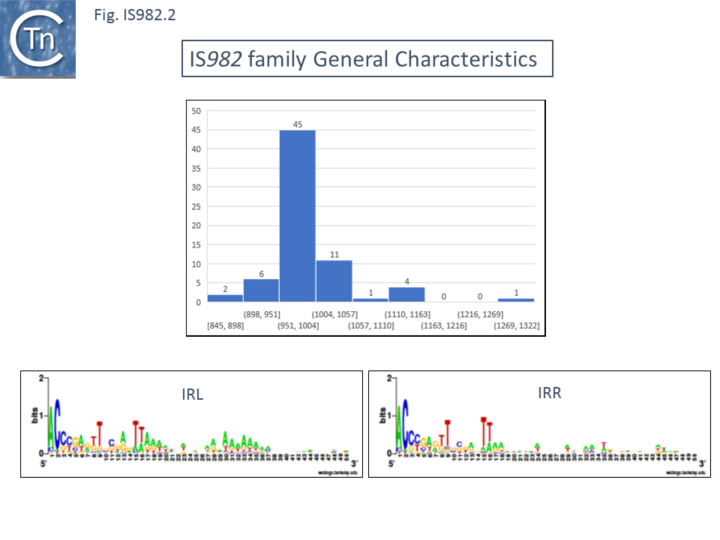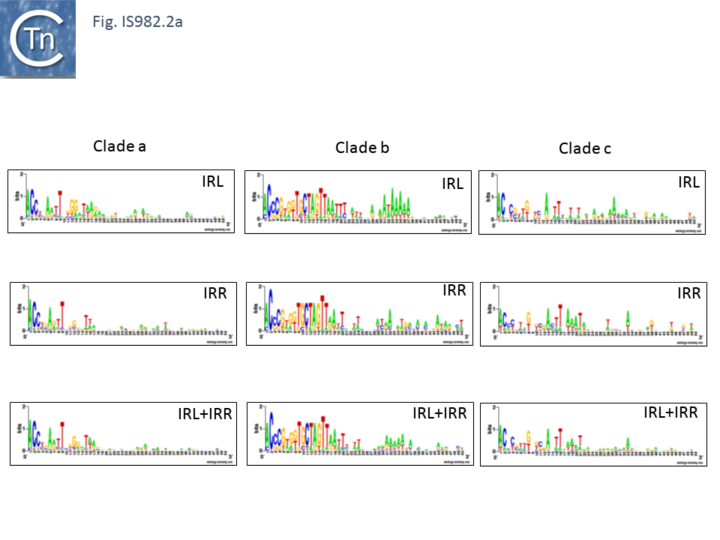IS Families/IS982 family
General
The IS982 family has over 70 entries in ISfinder from over 40 bacterial and archaeal species. In the case of ISLpl4 from Lactobacillus plantarum identical copies have been detected in Leuconostoc mesenteroides, Oenococcus oeni, and Lactobacillus sakei indicating horizontal gene transfer. Historically, a single IS982 family member, ISPfu3, was first identified in the archaea from the archaea Pyrococcus furiosus and this was later joined by ISTli1 from Thermococcus litoralis (both mrmbero of the order Thermococcales).
A phylogenetic tree of the transposase of family members (Fig. IS982.1) shows three deeply branching clades (a, b and c) which broadly correspond to those identified by Fayad et al. [1]. They can be further subdivided into several subclades (ai; aii and aii; bi, which includes streptococci and lactococci; and bii which contain bacilli and lactobacilli)
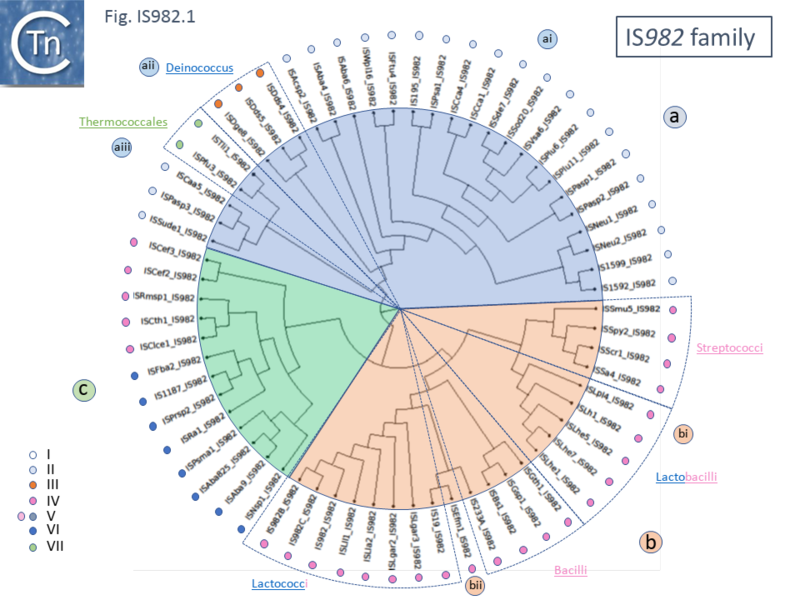
A recent extensive BLAST search in the non-redundant public databases using transposase examples from each of the major clades and a threshold of greater than 30% identity [1] indicated that members of this family are widely distributed over bacterial and archaeal genera and species. This includes the Euryarchaeota Methanotorris formicicus and Methanocaldococcus bathoardescencs and alpha-, beta-, gama- and epsilon-protobacteria, firmicutes, deinococci, cyanobacteria and actinobacteria. In total 265 new genera containing IS982-related elements were ideidentified,though the IS copies from this analysis were not further characterized [1].
Like many IS, members of this family are able to increase gene expression presumably by supplying a promoter or by formation of a hybrid promoter on insertion upstream of a resident gene. At least two members, IS982B [2] and IS1187 [see [3][4][5]] can provide a -35 hexamer in their right IR capable of forming a hybrid promoter with a resident -10 .
A recent review of this family [1] lists a number of additional elements including ISAba4, ISAba9, ISAba47 and ISAba825 whose insertion can lead to increased carbapenem resistance in Acinetobacter baumannii [6][7][8][9][10][11][12]. In addition, as also pointed out by Fayad et al. [1], insertion of members of the family which lead to gene inactivation has been observed to result in: increased antibiotic resistance (vancomycin and teicoplanin by IS19 [13] and ISEfm1 [14] in Enterococcus faecium; carbapenem by ISAba825 disruption of the CarO membrane protein [15] in A. baumannii); reduced antibiotic resistance (daptomycin in Enterococcus faecium; [16]); or in decreased virulence (ISSa4 in S. agalactiae [17]; ISScr1 in Streptococcus criceti [18]; IS195 in Porphyromonas gingivalis [19]).
Organization
IS982 family members are between 962 and 1155 bp long (Fig.IS982.2), carry similar terminal IRs of between 18 and 35 bp with conserved ends: 5’-ACCC-3’ and generate DR of 6 to 8 bp e.g. ISSa4 from Streptococcus agalactiae generates 7 bp (or perhaps 9 bp) flanking DRs [17] and ISCce1 from Clostridium cellulovorans is flanked by 7 bp repeats [20]. There is some evidence that the IR consensus varies slightly according to each IS subgroup [1] (Fig.IS982.2a)
Family members encode a single orf of between of 271 and 313 amino acids with a possible DDE motif but without a convincing conserved downstream K/R residue. They exhibit between 33% and 44% amino acid identity. The identities are shown in the alignment included in (Fig.IS982.3 a and b) together with the DDE motif suggested by Fayad et al. [1]. The N-terminal domain, which includes a potential HTH DNA binding motif [1] is not shown.
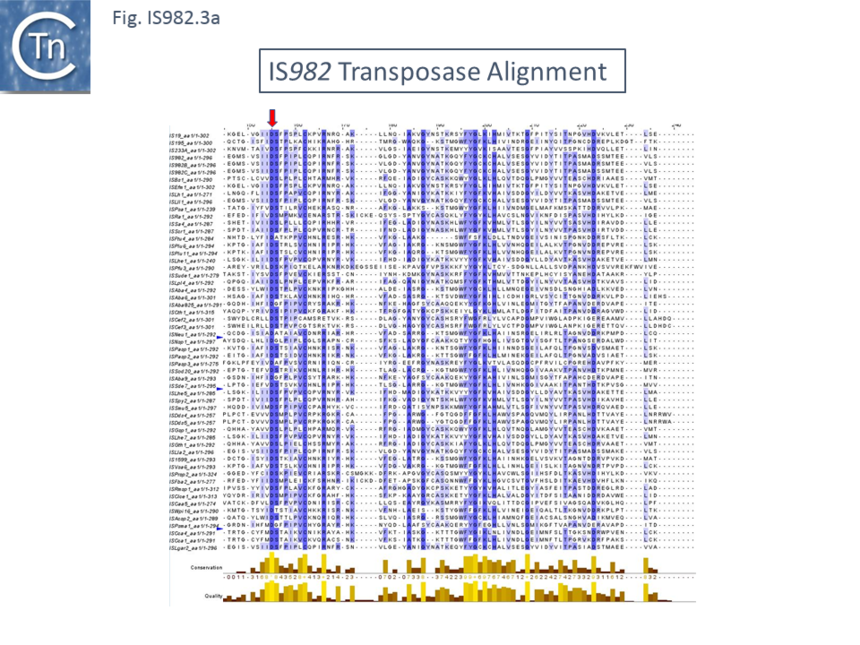
Although the Tpase of a majority of members occupies a single reading phase, there are several examples in which the gene is distributed over two phases. It has been reported that a +1 nucleotide insertion in the Tpase orf of an ISLpl4 from Oenococcus oeni may undergo programmed translational frameshifting at a low rate [21]. Although this must be confirmed, it would represent the first functional case of +1 frameshifting in IS. The Tpase of archaeal element ISPfu3 is also distributed over two phases. ISPfu3 carries a potential transcriptional frameshift signal A7 (PTR) present in all five copies, suggesting that ISPfu3 is active.
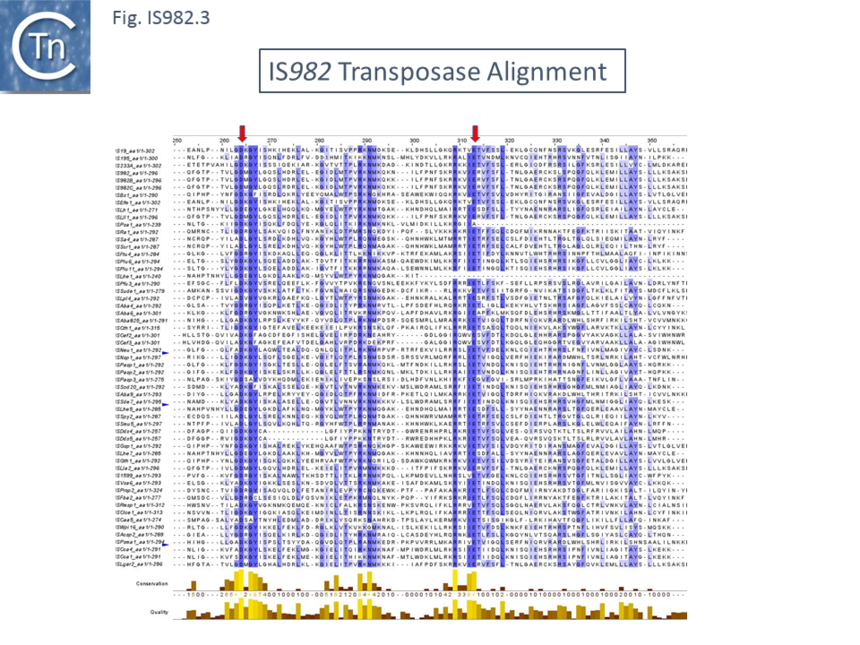
At present, there is no information concerning the transposition mechanism of this family.
Bibliography
- ↑ 1.00 1.01 1.02 1.03 1.04 1.05 1.06 1.07 1.08 1.09 1.10 Fayad N, Kallassy Awad M, Mahillon J . IS982 and kin: new insights into an old IS family. - Mob DNA: 2020, 11;24 [PubMed:32641975] [DOI]
- ↑ López de Felipe F, Magni C, de Mendoza D, López P . Transcriptional activation of the citrate permease P gene of Lactococcus lactis biovar diacetylactis by an insertion sequence-like element present in plasmid pCIT264. - Mol Gen Genet: 1996 Mar 7, 250(4);428-36 [PubMed:8602160] [DOI]
- ↑ Kato N, Yamazoe K, Han CG, Ohtsubo E . New insertion sequence elements in the upstream region of cfiA in imipenem-resistant Bacteroides fragilis strains. - Antimicrob Agents Chemother: 2003 Mar, 47(3);979-85 [PubMed:12604530] [DOI]
- ↑ Sóki J, Eitel Z, Urbán E, Nagy E, ESCMID Study Group on Anaerobic Infections . Molecular analysis of the carbapenem and metronidazole resistance mechanisms of Bacteroides strains reported in a Europe-wide antibiotic resistance survey. - Int J Antimicrob Agents: 2013 Feb, 41(2);122-5 [PubMed:23158541] [DOI]
- ↑ Podglajen I, Breuil J, Rohaut A, Monsempes C, Collatz E . Multiple mobile promoter regions for the rare carbapenem resistance gene of Bacteroides fragilis. - J Bacteriol: 2001 Jun, 183(11);3531-5 [PubMed:11344163] [DOI]
- ↑ Lopes BS, Al-Hassan L, Amyes SG . ISAba825 controls the expression of the chromosomal bla(OXA-51-like) and the plasmid borne bla(OXA-58) gene in clinical isolates of Acinetobacter baumannii isolated from the USA. - Clin Microbiol Infect: 2012 Nov, 18(11);E446-51 [PubMed:22862829] [DOI]
- ↑ Ravasi P, Limansky AS, Rodriguez RE, Viale AM, Mussi MA . ISAba825, a functional insertion sequence modulating genomic plasticity and bla(OXA-58) expression in Acinetobacter baumannii. - Antimicrob Agents Chemother: 2011 Feb, 55(2);917-20 [PubMed:21098239] [DOI]
- ↑ Khorsi K, Messai Y, Hamidi M, Ammari H, Bakour R . High prevalence of multidrug-resistance in Acinetobacter baumannii and dissemination of carbapenemase-encoding genes blaOXA-23-like, blaOXA-24-like and blaNDM-1 in Algiers hospitals. - Asian Pac J Trop Med: 2015 Jun, 8(6);438-46 [PubMed:26194827] [DOI]
- ↑ Villalón P, Valdezate S, Medina-Pascual MJ, Carrasco G, Vindel A, Saez-Nieto JA . Epidemiology of the Acinetobacter-derived cephalosporinase, carbapenem-hydrolysing oxacillinase and metallo-β-lactamase genes, and of common insertion sequences, in epidemic clones of Acinetobacter baumannii from Spain. - J Antimicrob Chemother: 2013 Mar, 68(3);550-3 [PubMed:23143900] [DOI]
- ↑ Levy-Blitchtein S, Roca I, Plasencia-Rebata S, Vicente-Taboada W, Velásquez-Pomar J, Muñoz L, Moreno-Morales J, Pons MJ, Del Valle-Mendoza J, Vila J . Emergence and spread of carbapenem-resistant Acinetobacter baumannii international clones II and III in Lima, Peru. - Emerg Microbes Infect: 2018 Jul 4, 7(1);119 [PubMed:29970918] [DOI]
- ↑ Potron A, Poirel L, Croizé J, Chanteperdrix V, Nordmann P . Genetic and biochemical characterization of the first extended-spectrum CARB-type beta-lactamase, RTG-4, from Acinetobacter baumannii. - Antimicrob Agents Chemother: 2009 Jul, 53(7);3010-6 [PubMed:19380596] [DOI]
- ↑ Figueiredo S, Poirel L, Papa A, Koulourida V, Nordmann P . Overexpression of the naturally occurring blaOXA-51 gene in Acinetobacter baumannii mediated by novel insertion sequence ISAba9. - Antimicrob Agents Chemother: 2009 Sep, 53(9);4045-7 [PubMed:19564367] [DOI]
- ↑ Perichon B, Casadewall B, Reynolds P, Courvalin P . Glycopeptide-resistant Enterococcus faecium BM4416 is a VanD-type strain with an impaired D-Alanine:D-Alanine ligase. - Antimicrob Agents Chemother: 2000 May, 44(5);1346-8 [PubMed:10770774] [DOI]
- ↑ Boyd DA, Conly J, Dedier H, Peters G, Robertson L, Slater E, Mulvey MR . Molecular characterization of the vanD gene cluster and a novel insertion element in a vancomycin-resistant enterococcus isolated in Canada. - J Clin Microbiol: 2000 Jun, 38(6);2392-4 [PubMed:10835012] [DOI]
- ↑ Mussi MA, Limansky AS, Viale AM . Acquisition of resistance to carbapenems in multidrug-resistant clinical strains of Acinetobacter baumannii: natural insertional inactivation of a gene encoding a member of a novel family of beta-barrel outer membrane proteins. - Antimicrob Agents Chemother: 2005 Apr, 49(4);1432-40 [PubMed:15793123] [DOI]
- ↑ Sinel C, Cosquer T, Auzou M, Goux D, Giard JC, Cattoir V . Sequential steps of daptomycin resistance in Enterococcus faecium and reversion to hypersusceptibility through IS-mediated inactivation of the liaFSR operon. - J Antimicrob Chemother: 2016 Oct, 71(10);2793-7 [PubMed:27353469] [DOI]
- ↑ 17.0 17.1 Spellerberg B, Martin S, Franken C, Berner R, Lütticken R . Identification of a novel insertion sequence element in Streptococcus agalactiae. [email protected]. - Gene: 2000 Jan 4, 241(1);51-6 [PubMed:10607898] [DOI]
- ↑ Tamura H, Yamada A, Kato H . Characterization of Streptococcus criceti insertion sequence ISScr1. - Genes Genet Syst: 2012, 87(3);153-60 [PubMed:22976390] [DOI]
- ↑ Lewis JP, Macrina FL . IS195, an insertion sequence-like element associated with protease genes in Porphyromonas gingivalis. - Infect Immun: 1998 Jul, 66(7);3035-42 [PubMed:9632563] [DOI]
- ↑ Tamaru Y, Doi RH . The engL gene cluster of Clostridium cellulovorans contains a gene for cellulosomal manA. - J Bacteriol: 2000 Jan, 182(1);244-7 [PubMed:10613891] [DOI]
- ↑ de Las Rivas B, Marcobal Ae, Gómez A, Muñoz R . Characterization of ISLpl4, a functional insertion sequence in Lactobacillus plantarum. - Gene: 2005 Dec 19, 363;202-10 [PubMed:16278055] [DOI]
